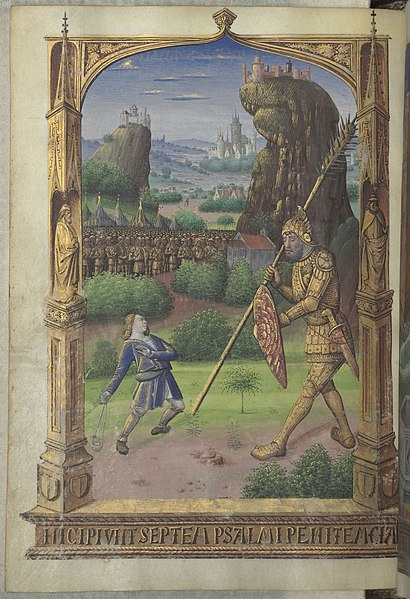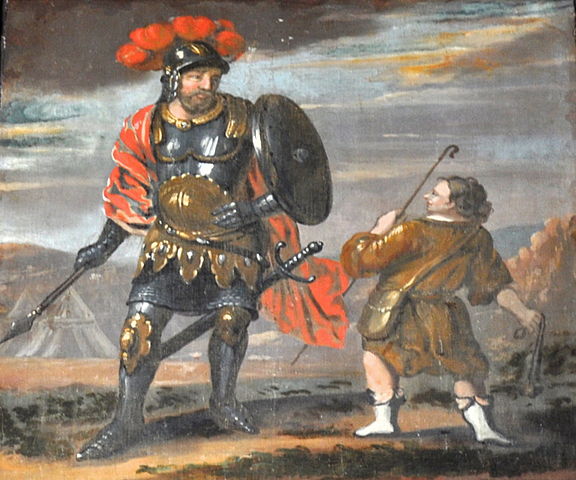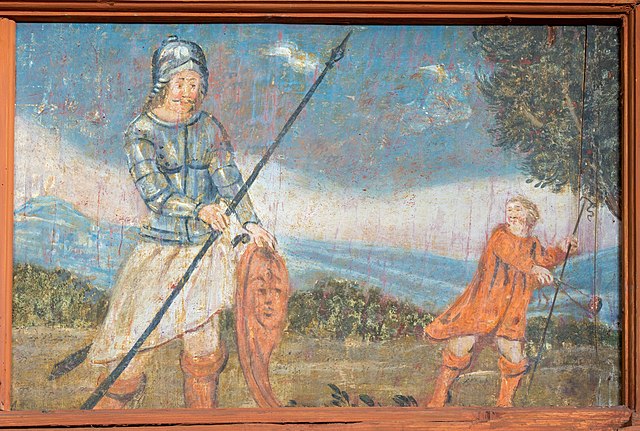
The Thammasat University Library has newly acquired a book that should be useful for students interested in religious studies, history, folklore, and related fields.
Goliath as Gentle Giant: Sympathetic Portrayals in Popular Culture by Jonathan L. Friedmann is about a Philistine giant described in the biblical Book of Samuel who was defeated by the young David in combat.
The phrase David and Goliath has taken on a popular meaning in English to refer to an underdog situation in which a smaller, weaker opponent is confronted by a bigger, stronger opponent.
The TU Library collection includes another book by Dr. Friedmann as well as many books on different aspects of the Bible.
In the Hebrew Bible, Goliath is a giant familiar from folklore, a violent, noisy, and not too intelligent aggressor. However, more recently in the West, popular culture has tried to see some more sympathetic sides to Goliath.

Examples from The Bangkok Post of how often comparisons are made to David and Goliath are seen from a 2019 article:
David and Goliath Tour de France battle changed oldest survivor’s life forever
PARIS – The oldest surviving wearer of the Tour de France leader’s yellow jersey, 93-year-old Jacques Marinelli, says he is still dining out on the achievement 70 years later.
Marinelli led cycling’s top race for six days in 1949, as France was still rebuilding after World War II. The exploit would change his life foreer, giving him not only sporting recognition but success in business and politics.
The Frenchman was given the nickname of ‘the budgie’ for his fierce struggle with Tour de France legend Fausto Coppi, depicted in newspaper cartoons as a heron or eagle because of the distinctive shape of his nose.
Because Marinelli was so small and donning the yellow jersey given to leaders of the multi-stage race, the name stuck and the French public had found their hero of the hour in the combative Frenchman.
Capturing the public imagination with his valiant stint in yellow after a gritty stage-four win, the then 23-year-old could never have imagined he would become a major retailer in the Paris region and later mayor of the wealthy town of Melun.
“I was on form,” he told AFP. “I was a talented rider, but I wasn’t one of the greats and I never dreamed of taking the yellow jersey.”
But in post-war France the story went down like a dream with Marinelli cast as a plucky David to Coppi’s seemingly unbeatable Goliath and the sports press, which enjoyed a huge readership at that time, did the rest.
Two years earlier, also in The Bangkok Post, the metaphor was used in a business article:
David vs Goliath in the supply chain
With the Internet of Things (IoT) and the “digital first” lifestyle becoming mainstream, large and established companies (Goliaths) are under attack by advancing startups (Davids).
These Davids are deconstructing markets into highly customised niches so that the Goliaths can’t compete on scale alone. They are attacking specific products and services rather than an entire portfolio, aiming to inflict a “death by a thousand cuts” on an established Goliath.
It’s becoming clear that these new companies are well positioned to achieve greater success than originally envisioned and may displace many Fortune 500 brands over the next decade or two.
Take the automotive industry as an example. New cars have become far more than just a means of getting from A to B, thanks to the connectivity being built into them. With connected cars having embedded sensors and communication capabilities, carmakers and their product-focused partners are able to design new services built around the ability of the car to interact with other vehicles and the surrounding infrastructure.
Cars are already producing more data than any other piece of consumer equipment and will produce even more of it in the future. Data could include anything from in-car phone usage, to all the locations you navigate to, or your choice of petrol stations. Car-specific data points could include fuel or oil levels and type, through to parts performance and potential failures.
This data will also be of great interest to third parties, who will pay carmakers a fee to access it. This can range from selling insurance at prices based on a user’s driving behaviour to generating insights for retailers about the best locations for new stores. Consequently, automobile companies see some of their technology partners showing an interest in making the car a natural extension of their “connected life” strategies.
Connectivity is turning data into a pot of gold for original equipment manufacturers (OEMs) and their technology partners. Accenture estimates that connectivity will rise 98% by 2020 and that by 2025, all new cars will be connected. It calculates that connectivity and the associated data access could be worth nearly £4,000 in extra revenue for a carmaker over a vehicle’s lifespan.
The three main sources of revenue are likely to be up-selling to vehicles with additional services at 22%, cross-selling new, connectivity-enabled services (21%) and data monetisation (19%).
As data becomes the new profit centre in the automotive industry, the battle is on between digitally native, vertically integrated startups (Davids) and established OEM powerhouses (Goliaths) over who will gain ownership of in-car behavioural data.
In the complex automotive manufacturing supply chain, there is a hierarchical structure that runs from companies that produce the raw materials all the way to the companies that sell products with the brands that we know. Today OEMs such as Ford, GM and Toyota are at the top of that food chain.
Back in the days when Henry Ford built the massive Rouge plant in Dearborn, Michigan, the big automakers were highly vertically integrated, bringing raw materials such as iron ore, lumber, leather hides and raw rubber into one end of the plant and shipping out finished cars from the other.
Over the last few decades, OEMs have offloaded most component development and production to several tiers of suppliers. At the top are tier-one suppliers who buy materials and parts from tier-two suppliers and below, and deliver finished sub-systems such as wiring harnesses, driver assistance devices and transmissions directly to OEM assembly lines.
However, as connectivity gains momentum, power in the supply chain is shifting in favour of technology companies that capture and own the most important customer data. A recent example is Waymo, the autonomous car development spin-off of Google parent Alphabet Inc. It has gone into partnership with Fiat Chrysler, which has essentially become a tier-one supplier (of vehicles in this case) to Waymo, which is indeed a dramatic shift. Waymo will retain ownership of the vehicles along with control of all the data they generate.
The final verdict? The Davids have already won the battle against the Goliaths if we have to go by the words of Bill Ford, executive chairman if Ford Motor Company: “In my great-grandfather’s time, when he founded Ford, there was a single vertical [that] did everything. But one company shouldn’t know it all or do it all. It’s the company that can stitch all that together to make people’s lives easier [that] will emerge as a winner. It will require partnerships with big technology companies and also with startups.”
There are many other examples of journalists citing the precedent of David and Goliath in the context of sports, military history, law, food, information technology, industrialization, and other fields of activity.

(All images courtesy of Wikimedia Commons)
